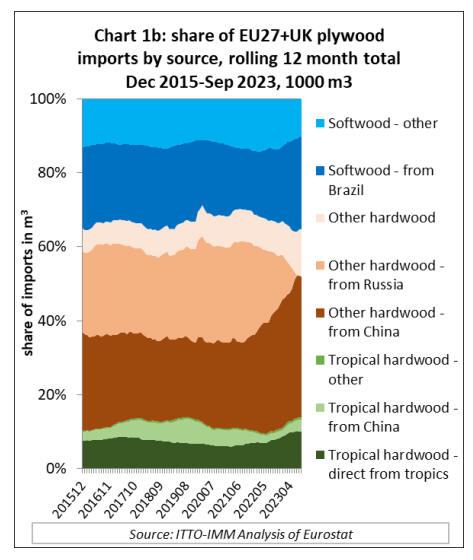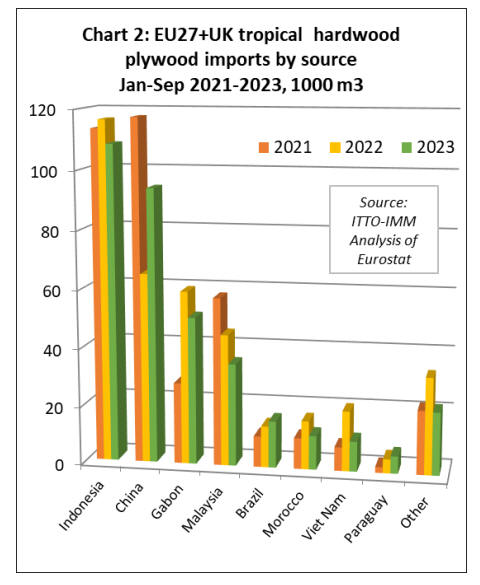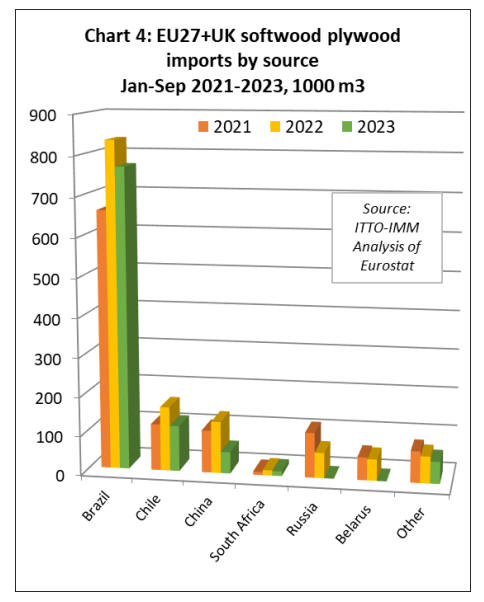|
Report from
Europe
Plywood imports fall from record highs to record lows
For the first time ever in a 12-month period, total EU+UK
imports of plywood from outside the region exceeded 5
million cu.m between 1t July 2021 and 30th June 2022.
However, by the end of September 2023, the twelve-
month rolling total had fallen to just 3.3 million cu.m
(Chart 1a).
If imports remain weak in the fourth quarter, which seems
likely, total EU+UK imports for the whole of 2023 could
fall below 3.1 million cu.m, which is the previous record
low occurring during the global financial crises in 2009.

In the first nine months of 2023, total EU+UK plywood
imports from outside the region were 2.67 million cu.m,
30% less than the same period in 2022. Imports of tropical
plywood were down 6% at 353,000 cu.m, imports of
temperate hardwood plywood were down 38% at 1.31
million cu.m, and imports of softwood plywood were
down 24% to 1.01 million cu.m.
The recent extreme volatility in EU+UK plywood imports
is due largely to geo-political issues, mainly relating to the
Russia Federation, combined with the lingering effects of
the COVID pandemic. EU+UK plywood imports from the
Russian Federation were rising almost continuously
between 2014 and 2019, encouraged by extreme weakness
of the Russian ruble against the euro and other EU
currencies.
At that time, a sharp decline in confidence in the Russian
economy following a collapse in oil prices and economic
sanctions on Russia following the country's annexation of
Crimea had led Russian manufacturers to boost exports in
search of hard currency.
Most plywood that was imported into the EU+UK from
Russia during the period comprised birch plywood,
including thicker film-faced boards which competed
directly with tropical products, and most was destined for
Germany, the Baltic States, Poland, the UK, and
Netherlands.
EU demand for plywood at this time was given added
impetus by a design trend to use plywood as the sole
manufacturing material in furniture and interior finishes,
with faces and edges expressed, even unfinished, to reveal
its structure and achieve an ‘industrial look’.
Birch was the favored species in these applications.
EU+UK plywood imports from Russia and elsewhere
dipped a little in early 2020 with the onset of the pandemic
but reached new heights in 2021 and the first half of 2022
with the sharp rebound in construction and DIY activity
after the first lockdown period.
Then, in February 2022, Russia invaded Ukraine and the
EU and UK responded by imposing economic sanctions
on Russia and Belorussia, including a total ban on all
imports of timber products from both countries. Some
large European companies also responded with their own
self-imposed boycotts of products from these countries.
Direct EU+UK imports of Russian and Belorussian
plywood had fallen to negligible levels by August 2022.
This occurred just at a time when the wider European
economy was beginning to cool against the background of
sharply rising interest rates to control high levels of
inflation, itself partly driven by a massive hike in energy
prices as availability of Russian gas and oil was curtailed.
Public funds to support post-COVID recovery were also
being progressively removed, while confidence was
severely hit by the political instability in Eastern Europe
and the downturn in the wider global economy.

As a result, the anticipated surge in plywood imports into
Europe from alternative supply countries following the
removal of Russian and Belorussian products from the
market was less dramatic than expected. By far the biggest
gain in market share was made by temperate hardwood
plywood from China (Chart 1b left).
There was also a surge in birch plywood imports into the
EU from Kazakhstan, raising immediate concerns that
some European importers were deliberately circumventing
the sanctions by sourcing Russian birch plywood from
third countries.
For tropical hardwood suppliers, EU plywood importers
were rushing to buy Indonesian products in the second and
third quarters of 2022 and Indonesian mills were being
encouraged to ramp up production as much as possible for
the EU market and to relaunch production of thicker film-
faced boards.
However, the ability of Indonesian mills to do this was
constrained by lack of log supply and existing demand for
their products in other markets. By far the biggest gains in
EU imports of plywood faced with tropical hardwood
during 2022 were made by products from China and
Gabon.
The signs are that EU domestic plywood manufacturers
were also unable to significantly increase production in
response to the supply gap that opened following the
sanctions on Russian and Belorussian products. Data from
the European Panels Federation indicates that total EU
plywood production fell 2.5% from 3.2 million cu.m in
2021 to 3.1 million cu.m in 2022. Similarly, Eurostat data
shows that production of plywood in Finland, by far the
largest birch plywood manufacturing country in the EU,
fell from 1.13 million cu.m in 2021 to 1.11 million cu.m in
2022.
This year, EU+UK imports of tropical plywood have held
up better than imports of both temperate hardwood and
softwood plywood. In the first nine months of 2023,
EU+UK plywood imports of tropical plywood were down
only 6% at 353,000 cu.m. However, direct imports from
the tropics fell 15% to 244,000 cu.m.
The relative stability in overall imports was mainly due to
a 45% increase, to 94,000 cu.m, in imports of plywood
faced with tropical hardwood from China. Most Chinese
product was destined for the UK and the rise this year in
fact represents a rebound to more normal levels after a
sharp downturn in 2022 due to supply problems during
COVID lockdowns in China.

As a result, the anticipated surge in plywood imports into
Europe from alternative supply countries following the
removal of Russian and Belorussian products from the
market was less dramatic than expected. By far the biggest
gain in market share was made by temperate hardwood
plywood from China (Chart 1b left).
There was also a surge in birch plywood imports into the
EU from Kazakhstan, raising immediate concerns that
some European importers were deliberately circumventing
the sanctions by sourcing Russian birch plywood from
third countries.
For tropical hardwood suppliers, EU plywood importers
were rushing to buy Indonesian products in the second and
third quarters of 2022 and Indonesian mills were being
encouraged to ramp up production as much as possible for
the EU market and to relaunch production of thicker film-
faced boards.
However, the ability of Indonesian mills to do this was
constrained by lack of log supply and existing demand for
their products in other markets. By far the biggest gains in
EU imports of plywood faced with tropical hardwood
during 2022 were made by products from China and
Gabon.
The signs are that EU domestic plywood manufacturers
were also unable to significantly increase production in
response to the supply gap that opened following the
sanctions on Russian and Belorussian products. Data from
the European Panels Federation indicates that total EU
plywood production fell 2.5% from 3.2 million cu.m in
2021 to 3.1 million cu.m in 2022. Similarly, Eurostat data
shows that production of plywood in Finland, by far the
largest birch plywood manufacturing country in the EU,
fell from 1.13 million cu.m in 2021 to 1.11 million cu.m in
2022.
This year, EU+UK imports of tropical plywood have held
up better than imports of both temperate hardwood and
softwood plywood. In the first nine months of 2023,
EU+UK plywood imports of tropical plywood were down
only 6% at 353,000 cu.m. However, direct imports from
the tropics fell 15% to 244,000 cu.m.
The relative stability in overall imports was mainly due to
a 45% increase, to 94,000 cu.m, in imports of plywood
faced with tropical hardwood from China. Most Chinese
product was destined for the UK and the rise this year in
fact represents a rebound to more normal levels after a
sharp downturn in 2022 due to supply problems during
COVID lockdowns in China.

Considering EU+UK plywood direct imports from tropical
countries between January and September this year,
Indonesia was down 7% at 108,400 cu.m, Gabon was
down 15% at 51,500 cu.m, Malaysia was down 22% at
35,100 cu.m, Morocco was down 30% at 11,600 cu.m, and
Vietnam was down 50% at 10,300 cu.m.
However, imports of tropical hardwood plywood from
Brazil increased 13% to 16,000 cu.m, while imports from
Paraguay increased 24% to 5,900 cu.m (Chart 2 above).
In the first nine months of this year, EU+UK plywood
imports of temperate hardwood plywood were down 38%
at 1.31 million cu.m. The decline was mainly due to
imports from Russia and Belarus, which were 591,000
cu.m and 113,000 cu.m respectively in the first nine
months last year, falling to zero this year.

Imports of temperate hardwood plywood from China were
also down 20% at 969,000 cu.m during the January to
September period, while imports from Ukraine fell 6% to
116,000 cu.m.
A rise in imports from Kazakhstan - from negligible levels
to 112,000 cu.m in the first nine months of this year - and
a doubling of imports from Turkey, to 47,000 cu.m, did
little to offset the overall downturn (Chart 3 left).
In the first nine months of 2023, EU+UK softwood
plywood imports were down 24% to 1.01 million cu.m. In
the case of softwood plywood, the decline in imports was
across the board for all major supply countries (Chart 4).
Again, imports from Russia and Belarus were at zero this
year, but these countries were only ever relatively minor
suppliers of softwood plywood into the EU+UK,
contributing 65,000 cu.m and 55,000 cu.m respectively in
the first nine months of last year.
Bigger declines in absolute import volumes were recorded
for softwood plywood from Brazil (down 8% to 769,000
cu.m), Chile (down 29% to 117,000 cu.m), and China
(down 58% to 55,000 cu.m).

A clear indicator of the overall weakness of the EU+UK
plywood market this year is that it took much longer than
usual for the duty-free softwood import quota – set this
year at 482,648 cu.m in the EU and 201,500 cu.m in the
UK - to be filled. The EU quota was only filled in July,
whereas the UK quota was only filled in September.
Meanwhile, the EU and UK sanctions on imports of
Russian plywood have significant knock-on effects for the
global plywood market.
In a presentation to the FORESTA 2023 conference held
in San Marino in November, Mr. Nikolay Ivanov of the
Union of Timber Manufacturers and Exporters of Russia,
reported that overall birch plywood production in Russia
was projected to fall only 5% from 3.3 million cu.m in
2022 to 3.15 million cu.m in 2023, while exports would
fall more dramatically, by 19%, from 1.98 million cu.m to
1.60 million cu.m.
This implies that apparent consumption of birch plywood
in Russia is expected to rise 11% from 1.41 million cu.m
last year to 1.56 million cu.m in 2023.
The balance of export destinations for Russian plywood is
also expected to change dramatically. In 2022, the leading
destinations, in order of share (by volume) were Europe
(35%), Middle East and North Africa (34%), North
America (11%), other CIS (10%), China (6%), South
Korea (2%), and all others accounting for 3%. In 2023, the
forecast share of export destinations is Middle East and
North Africa (47%), China (16%), other CIS (15%), North
America (15%), South Korea (4%), and all others
accounting for 3%.
In other words, with Europe no longer buying Russian
plywood, larger volumes are now being distributed in
other parts of the world, particularly in the Middle East
and North Africa, China, and CIS countries, notably in
South Asia.
A small proportion of these products may be finding their
way, indirectly, into the European market, but most will be
competing with other plywood and panel suppliers in other
global markets.
|